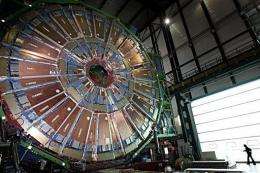A view of a superconducting solenoid magnet at the European Organization for Nuclear Research (CERN) near Geneva. The European Organisation for Nuclear Research (CERN) said that the world's biggest atom smasher is swiftly gaining pace as scientists seek to unravel the secrets of the universe.
The world's biggest atom smasher is swiftly gaining pace as scientists seek to unravel the secrets of the universe, the European Organisation for Nuclear Research (CERN) said on Monday.
The Large Hadron Collider has been setting records for the intensity of proton collisions since scientists started firing beams of the sub-atomic particles at unprecedented energy levels on March 30, CERN spokesman James Gillies said.
"It's about CERN breaking its own records," he told AFP on Monday.
"We had one good run over the weekend when we were getting double the data sets that we had since the beginning," Gillies added.
"You'll keep on hearing this but we've got a long way to go."
The beams thrust around the 27-kilometre (16.8-mile) accelerator collide at nearly the speed of light, creating powerful but microscopic bursts of energy that mimic conditions close to the Big Bang that created the universe.
Scientists around the world are expected to take years to analyse the huge flow of data on a giant computer network, searching for evidence of a theorised missing link called the Higgs Boson, commonly called the "God Particle".
The experiment is still in the early stages of an initial 18- to 24-month run of billions of collisions.
Gillies said the "luminosity" of the beams -- a measure of their intensity and the frequency of collisions -- had been ramped up to 10 to the power 29, compared with 10 to the power 27 nearly three months ago.
Ten to the power 30 is scheduled for this week with a target of 10 to the power 34.
Scientists carefully examine each increase for safety and the reliability of the accelerator in a ring-shaped tunnel straddling the French-Swiss border near Geneva.
"Every time we increase the luminosity it comes with increased energy," said Gillies.
CERN hailed a new era for science when it began smashing atoms at energy levels of seven trillion (tera) electronvolts (TeV) on March 30.
It is aiming to trigger collisions at twice the energy, 14 TeV, equivalent to 99.99 percent of the speed of light, in the cryogenically-cooled machine after 2011.
At full power, the detectors in cathedral-sized underground chambers should capture some 600 million collisions every second among trillions of protons racing around the collider 11,245 times a second.
(c) 2010 AFP























